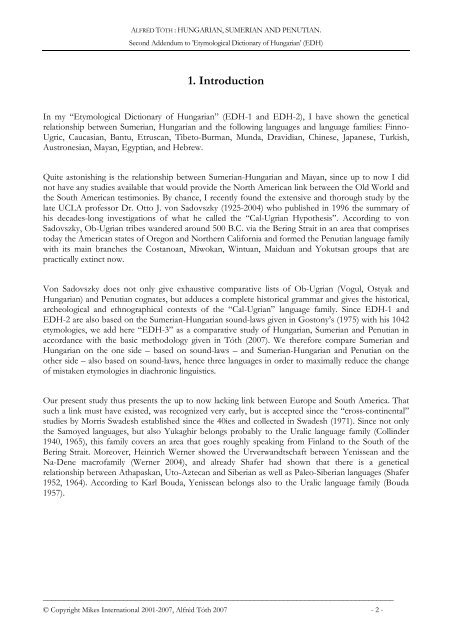Hungarian, Sumerian and Penutian.
Hungarian, Sumerian and Penutian.
Hungarian, Sumerian and Penutian.
You also want an ePaper? Increase the reach of your titles
YUMPU automatically turns print PDFs into web optimized ePapers that Google loves.
ALFRÉD TÓTH : HUNGARIAN, SUMERIAN AND PENUTIAN.<br />
Second Addendum to ’Etymological Dictionary of <strong>Hungarian</strong>’ (EDH)<br />
1. Introduction<br />
In my “Etymological Dictionary of <strong>Hungarian</strong>” (EDH-1 <strong>and</strong> EDH-2), I have shown the genetical<br />
relationship between <strong>Sumerian</strong>, <strong>Hungarian</strong> <strong>and</strong> the following languages <strong>and</strong> language families: Finno-<br />
Ugric, Caucasian, Bantu, Etruscan, Tibeto-Burman, Munda, Dravidian, Chinese, Japanese, Turkish,<br />
Austronesian, Mayan, Egyptian, <strong>and</strong> Hebrew.<br />
Quite astonishing is the relationship between <strong>Sumerian</strong>-<strong>Hungarian</strong> <strong>and</strong> Mayan, since up to now I did<br />
not have any studies available that would provide the North American link between the Old World <strong>and</strong><br />
the South American testimonies. By chance, I recently found the extensive <strong>and</strong> thorough study by the<br />
late UCLA professor Dr. Otto J. von Sadovszky (1925-2004) who published in 1996 the summary of<br />
his decades-long investigations of what he called the “Cal-Ugrian Hypothesis”. According to von<br />
Sadovszky, Ob-Ugrian tribes w<strong>and</strong>ered around 500 B.C. via the Bering Strait in an area that comprises<br />
today the American states of Oregon <strong>and</strong> Northern California <strong>and</strong> formed the <strong>Penutian</strong> language family<br />
with its main branches the Costanoan, Miwokan, Wintuan, Maiduan <strong>and</strong> Yokutsan groups that are<br />
practically extinct now.<br />
Von Sadovszky does not only give exhaustive comparative lists of Ob-Ugrian (Vogul, Ostyak <strong>and</strong><br />
<strong>Hungarian</strong>) <strong>and</strong> <strong>Penutian</strong> cognates, but adduces a complete historical grammar <strong>and</strong> gives the historical,<br />
archeological <strong>and</strong> ethnographical contexts of the “Cal-Ugrian” language family. Since EDH-1 <strong>and</strong><br />
EDH-2 are also based on the <strong>Sumerian</strong>-<strong>Hungarian</strong> sound-laws given in Gostony’s (1975) with his 1042<br />
etymologies, we add here “EDH-3” as a comparative study of <strong>Hungarian</strong>, <strong>Sumerian</strong> <strong>and</strong> <strong>Penutian</strong> in<br />
accordance with the basic methodology given in Tóth (2007). We therefore compare <strong>Sumerian</strong> <strong>and</strong><br />
<strong>Hungarian</strong> on the one side – based on sound-laws – <strong>and</strong> <strong>Sumerian</strong>-<strong>Hungarian</strong> <strong>and</strong> <strong>Penutian</strong> on the<br />
other side – also based on sound-laws, hence three languages in order to maximally reduce the change<br />
of mistaken etymologies in diachronic linguistics.<br />
Our present study thus presents the up to now lacking link between Europe <strong>and</strong> South America. That<br />
such a link must have existed, was recognized very early, but is accepted since the “cross-continental”<br />
studies by Morris Swadesh established since the 40ies <strong>and</strong> collected in Swadesh (1971). Since not only<br />
the Samoyed languages, but also Yukaghir belongs probably to the Uralic language family (Collinder<br />
1940, 1965), this family covers an area that goes roughly speaking from Finl<strong>and</strong> to the South of the<br />
Bering Strait. Moreover, Heinrich Werner showed the Urverw<strong>and</strong>tschaft between Yenissean <strong>and</strong> the<br />
Na-Dene macrofamily (Werner 2004), <strong>and</strong> already Shafer had shown that there is a genetical<br />
relationship between Athapaskan, Uto-Aztecan <strong>and</strong> Siberian as well as Paleo-Siberian languages (Shafer<br />
1952, 1964). According to Karl Bouda, Yenissean belongs also to the Uralic language family (Bouda<br />
1957).<br />
___________________________________________________________________________________<br />
© Copyright Mikes International 2001-2007, Alfréd Tóth 2007 - 2 -

















